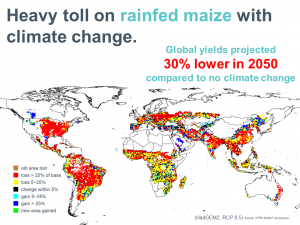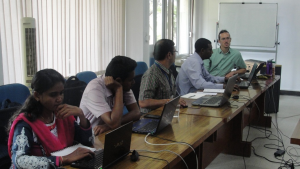By Richard Robertson, IFPRI —
Over the last decade, computer models of crop growth have increasingly been used to understand how climate change may affect the world's capacity to produce food. The International Food Policy Research Institute (IFPRI) has undertaken a major sustained effort to analyze changes in the productivity of major crops across the entire world. The results are integrated into economic modeling efforts ranging from household to country-level economy-wide models to the global agricultural sector partial-equilibrium economic model known as IMPACT. With the models working together, researchers can examine how biophysical changes in crop growth interact with changes in social and economic conditions.
Now, for the first time, IFPRI is releasing a comprehensive volume describing the global-scale crop modeling system behind IMPACT known as “Mink” for short. Download here.

Mink generates yield maps for the entire world that can be compared to identify locations most likely to be affected by climate change.
Crop modeling starts at the field level and scaling this up to the global level is challenging. Climate data must be collated, processed, and formatted. Representative crop varieties and planting calendars have to be chosen. Fertilizer input levels need to be specified. Myriad other assumptions need to be considered and appropriate values and strategies determined. And that is just the preparation phase. All the data then have to be organized, exported, and run through the crop models to obtain simulated yields under different climate scenarios and production environments. This necessitates employing parallel computing to get the job done quickly enough to be useful. And then the reams of output data must be organized, manipulated, analyzed, and finally interpreted to provide context as well as specific information so policymakers can plan appropriately for the future.

Collaborators from across the CGIAR and universities in India gather at ICRISAT to learn how to use Mink in support of their own research.
Naturally, with so much going on, the process can be mysterious for those looking in from the outside and potentially confusing even for those on the inside.
The document addresses how Mink works at several different levels. There is the broad discussion of interest to policymakers and managers concerning how global-scale crop modeling can be used, its strengths and weaknesses, how to think about the issues, and where it sits in the wider context of agricultural and policy research. At a middle level, every step of the process is described for those who wish to understand how it works so they can use the results properly, but not necessarily generate the numbers themselves. Along the way, though, various tips, tricks, and lessons learned are revealed for those who do, in fact, wish to replicate this kind of work on their own. And finally, for collaborators and researchers who wish to use Mink themselves, there is the nitty-gritty, nuts-and-bolts level documentation and tutorial aspects that literally say "Change this number; click here and drag there."
Mink has been used to provide insight for numerous reports, peer-reviewed journal articles, and the popular press, some examples being:
National Geographic. Climate Change: 5 Ways It Will Affect You: Crops. http://www.nationalgeographic.com/climate-change/how-to-live-with-it/crops.html
Rosegrant et al. 2017. Quantitative foresight modeling to inform the CGIAR research portfolio. http://ebrary.ifpri.org/cdm/ref/collection/p15738coll2/id/131144
Islam et al. 2016. Structural approaches to modeling the impact of climate change and adaptation technologies on crop yields and food security. Global Food Security 10: 63-70. http://dx.doi.org/10.1016/j.gfs.2016.08.003
Wiebe et al. 2015. Climate change impacts on agriculture in 2050 under a range of plausible socioeconomic and emissions scenarios. Environmental Research Letters 10: 085010. http://dx.doi.org/10.1088/1748-9326/10/8/085010
Müller and Robertson. 2014. Projecting future crop productivity for global economic modeling. Agricultural Economics 45: 37-50. http://dx.doi.org/10.1111/agec.12088
Rosegrant et al. 2014. Food security in a world of natural resource scarcity: The role of agricultural technologies. http://dx.doi.org/10.2499/9780896298477
We hope this volume will be a valuable resource for global modelers running simulations, their collaborators making use of the results, and ultimately for policymakers trying to determine appropriate courses of action in a changing world.
Major and ongoing support for this work has been provided by the Bill & Melinda Gates Foundation and the CGIAR Research Program on Policies, Institutions, and Markets (PIM) through the Global Futures and Strategic Foresight Project.





